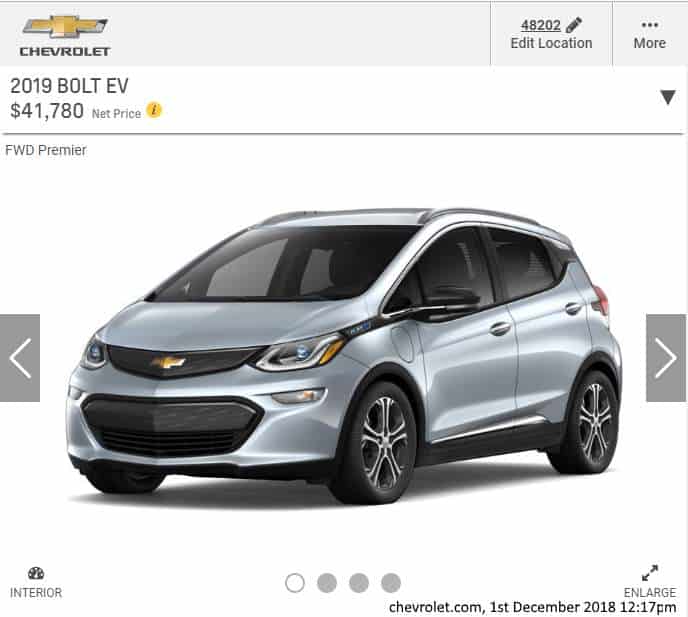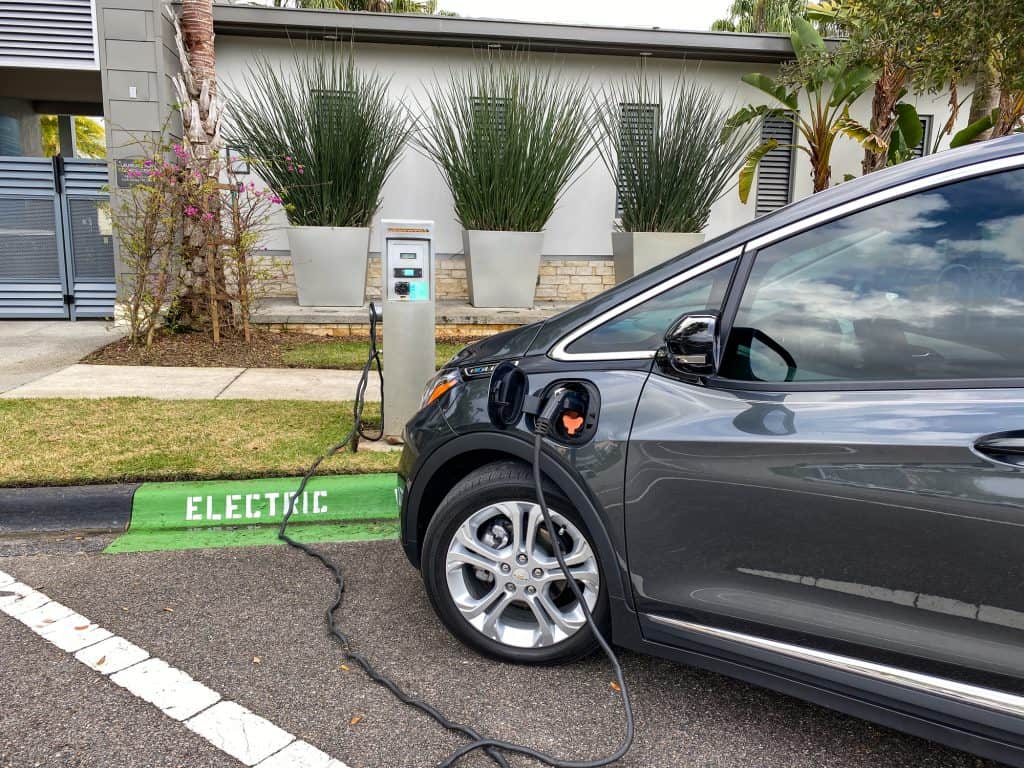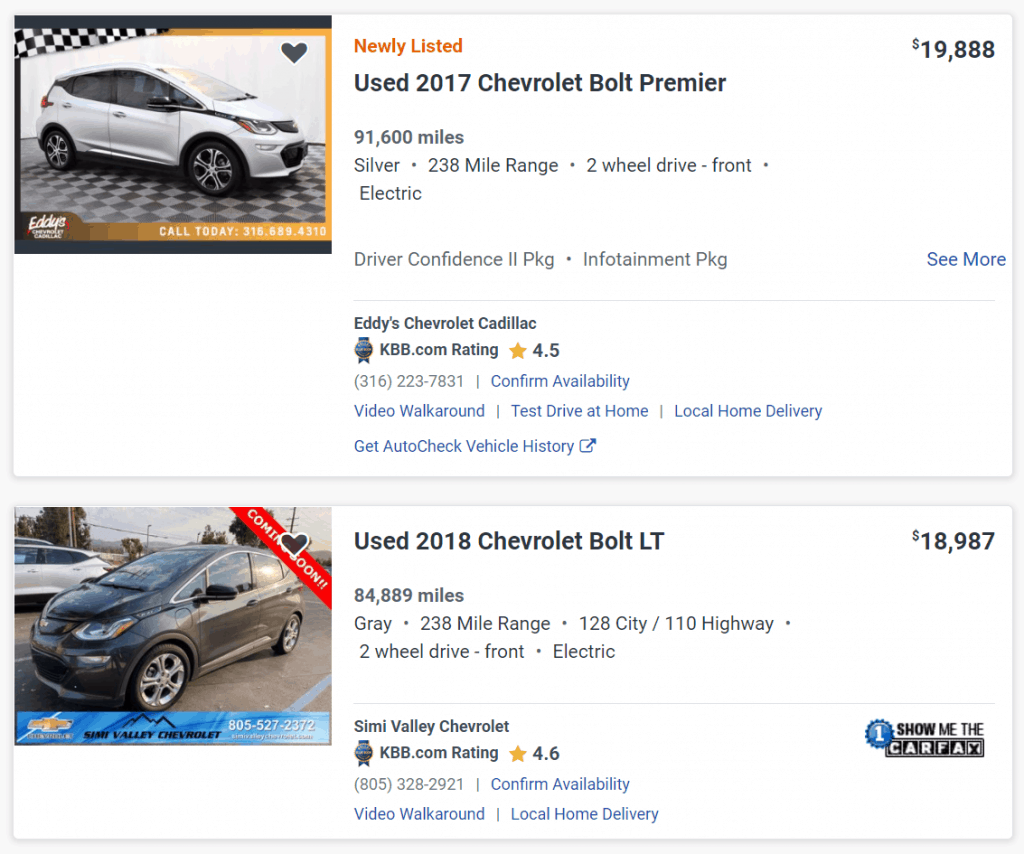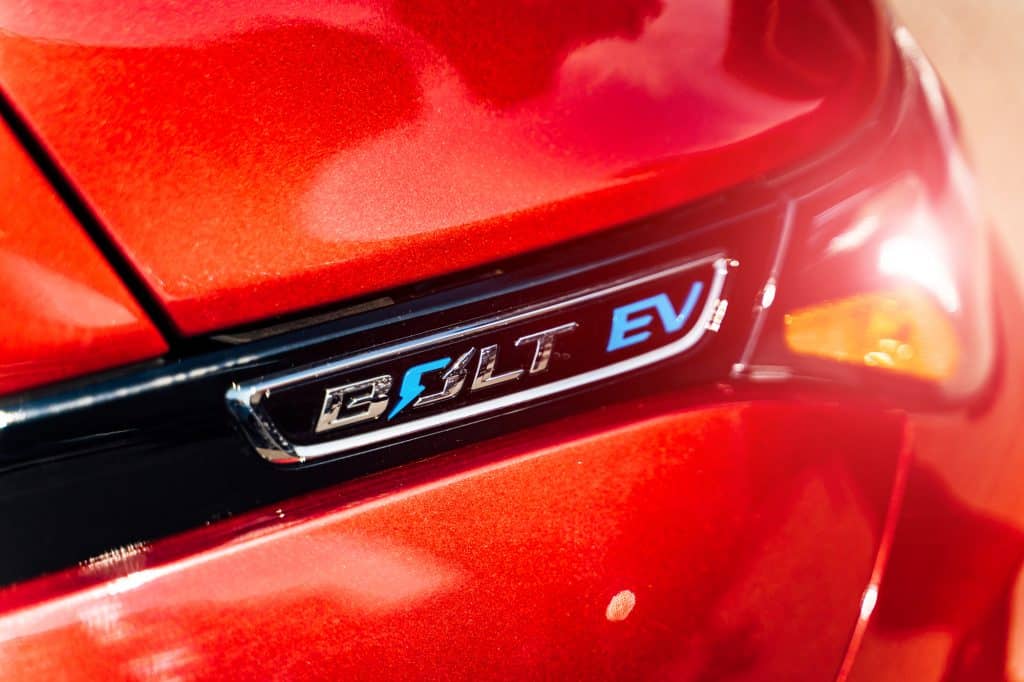The Chevrolet Bolt was first introduced to the world back in the 2017 model year. Now completing its 5th model year in 2021, and with Chevy now pushing the 2022 model, there is plenty of scope for a used Bolt marketplace. Given the still relatively high cost of full-electric cars compared to internal combustion engine cars or even regular hybrid cars, buying a used EV is a good way to save money and make the switch to an electric vehicle.
The core question behind today’s blog is what level of mileage could be considered too high to consider a Chevy Bolt purchase reasonable or advisory? The world of used EV sales is still relatively new, given that most all-electric cars only entered the market in earnest back in 2010 with models like the Nissan Leaf.
Hopefully, our buyers guide will help you avoid the potential pitfalls in buying a used Chevrolet Bolt.
Background: About the Chevrolet Bolt

As we mentioned above, the Chevrolet Bolt started production in 2016 for the 2017 model year. The first generation of Chevrolet Bolt cars was released in model years 2017 to 2021, making this year the final model year of the first-gen cars. The 2022 model — expected in summer 2021 — marks the arrival of the second generation.
Below are some key facts about the Chevy Bolt:
- Category: Subcompact
- Style: 5-door hatchback
- Platform: BEV II
- Motor: 139kW front electric motor generating 200hp and 269lb-ft of torque
- Transmission: 1-speed Electronic Precision Shift
- Battery: 60kWH (2017-2019); 66kWh (2020-Present) – both lithium-ion
- Range (EPA): 239 miles (2017-2019); 259 miles (2020-Present)
- Dimensions
- Wheelbase: 102.4 inches
- Length: 164 inches
- Width: 69.5 inches
- Height: 62.8 inches
- Curb weight: 3,563lbs
Development of the Bolt started in South Korea back in 2012 and by 2015 GM had made 50 Bolt prototypes which were all hand-built in Michigan. The production model was unveiled at the Consumer Electronics Show in Las Vegas in January 2016.
One additional point that should be mentioned for those who are interested in purchasing the Chevy Bolt is to do with its name. It is not to be confused with the Chevy Volt, which is a plug-in hybrid electric vehicle (PHEV) that has been around since 2010. The Volt is the older of the two kinds, and buyers looking for the battery electric vehicle (BEV) should be focused on the “Bolt” name, and not mixing it up with “Volt.”
What Would Be Considered “High Mileage” on a Chevy Bolt in 2021?

While there are already five available model years to look at and choose from within the used Bolt market, it’s not enough years to generate the more traditional view of what would constitute high mileage on a car. Typically, a used car with 80,000-100,000 miles on the clock would be considered something of a “veteran,” and we might not expect to pay so much for this car.
We can start our reflection on high-mileage bolts by first looking at two key aspects, namely the conditions of the warranty, and then the average annual mileage of the typical American driver.
Warranty
The standard new vehicle limited warranty for Chevrolet cars applies to the bolt. This is the bumper-to-bumper protection plan that is offered on all major components. It is for 3 years or 36,000 miles. The good folks at Chevrolet, therefore, predict that the driver will travel about 12,000 miles per year in their Bolt.
If you therefore are looking at a used Chevrolet Bolt that is either more than 3 years since its initial sale date and/or has more than 36,000 miles on the clock, then you are outside of the main new vehicle limited warranty.
That’s not always a problem for those seeking a used Chevrolet Bolt, however. The key part of the warranty that EV buyers are interested in is the battery. The battery pack is by far the single-most expensive critical component that is also destined to fail in ways that the owner cannot prevent. A new Chevy Bolt 66kWh battery pack is estimated to cost around $16,000, which is about 3 times more expensive than a Nissan Leaf 40kWh battery pack replacement ($5,500). That’s $240 per kWh on the Chevy Bolt.
The Chevy Bolt comes with an 8-year or 100,000-mile warranty on the battery, so that’s good news. This means that all Chevy Bolts that have fewer than 100,000 miles on their odometers should — saving for some very specific warranty-voiding reason — all be within their battery warranty. That’s a huge plus compared with other cars like the Nissan Leaf, the earliest models of which exited their battery warranties at least in 2018-2019.
Thinking of the battery warranty, then, any mileage under 100,000 miles means your battery is guaranteed by the manufacturer. Even if that fails, you can get a free replacement. In warranty terms, “high mileage” is essentially everything that falls outside of those safe warranty boundaries.
Average Annual Mileage

Next, let’s turn to the average mileage of the American driver. Assuming you’re buying your pre-owned Chevy Bolt in the United States, then you should expect the car to accrue about 13,500 miles on the odometer every year. That’s according to the US Department of Transportation, at least.
With that in mind, a high-mileage Bolt would be one that exceeds this average. If, for instance, you encountered a used Chevy Bolt for sale on Craigslist from the 2018 model year with 65,000 miles on it, then this is a Bolt that has been pushed quite a lot harder than the average. Below are some numbers showing what mileage you should expect to find on an average driver’s Chevy Bolt:
- 2017 MY: 54,000 miles
- 2018 MY: 40,500 miles
- 2019 MY: 27,000 miles
- 2020 MY: 13,500 miles
- 2021 MY: <13,500 miles
When driven at about the average mileage, you shouldn’t expect too many problems with the car. If it has been pushed far beyond these limits, however, then you will have more questions to ask and more risk to deal with. In the next section, we’ll look at some common problems that exist with the Chevrolet Bolt.
What Are Some Common Problems With the Chevrolet Bolt?
During its several years of development, the Chevrolet Bolt has actually been quite consistently praised as being among the most reliable EVs on the market. Forbes published an article in April 2021 that said in terms of both price and reliability, Forbes “favors 2021 Chevy Bolt EV over Tesla Model 3.” This is quite a statement.
The price point is obvious, with the 2021 Bolt starting about $3,000 cheaper than the Model 3. In terms of reliability, Forbes back up their claim citing data from Consumer Reports, which shows that in reliability out of 5, the Bolt was rated 5/5 and the Model 3 only 3/5.
None of this means the Bolt isn’t without its problems, however. Below are some examples of common problems with the Chevrolet Bolt. The first three issues below (Battery, brakes and visibility) were mostly connected to models from the early years 2017-2018.
Battery
There have been some complaints from owners about the Bolt battery suddenly losing charge and the car suddenly losing propulsion. There have been instances of the car being driven along displaying a full charge on the instrument cluster, before suddenly jumping to zero percent and the car dying. This obviously presented drivers with serious safety concerns. What if that were to happen on the interstate highway?
GM’s first response was to blame bad software for the issue, and GM issues instructions to dealers to offer reprogramming of the system to fix the problem. While this worked on many models, it didn’t work on all of them. The problem can happen if even a single cell is defective, and could therefore be repaired quite simply if that defective cell is identified. GM opted instead to simply replace battery packs that displayed this issue under the warranty agreement.
Brakes
Perhaps the most worrying issues ever reported on the Chevy Bolt were those relating to the car’s brakes. There were customers saying that they fully depressed the brake pedal but to no avail and even with sufficient braking distance they either collided or nearly collided with parked vehicles in front. The ramifications of this are obviously very frightening.
GM theorized that the issue might be down to faulty brake pistons. They issued a recall (N1821679000) to resolve the issue. GM discovered that on some Bolt cars, defective brake pistons were causing hydrogen gas to become trapped in the brake lines, which could greatly lengthen the braking distance.
Visibility
The dashboard in the Chevy Bolt is quite large in comparison to some vehicles. This has created some issues with driver visibility, especially among drivers who are of below-average height. It’s not only the size of the dashboard, but also the color that creates issues. The gray dash and interior trim in particular is known for creating so much glare for the driver that it reduces visibility to near zero, unless you happen to be wearing sunglasses at the time.
This issue was more common on the Premier trim levels in which these colors were offered as an option. Light Ash Gray and Ceramic White colored interiors on the Premium trim are the main ones for which owners should be wary.
Recall Over Fire Risk
Finally, there was another recall in November 2020 of 50,932 Bolt vehicles from model years 2017 to 2019. The recall was initiated over a potential fire risk caused by the presence of batteries of too high a voltage that could catch fire if and when they were charged to full capacity.
If you have a Chevy Bolt and plug it in every night into a level 2 charging station at home without limiting the maximum battery charge level, then you would be pushing your Bolt to a fire risk possibly every single night of the week. That’s an alarming thought.
Software upgrades from GM allowed users to impose a 90-percent charging limit on the battery to reduce the risk. The NHTSA confirmed 5 known fires which injured two people. The NHTSA recommended parking these vehicles outside for safety reasons.
Buyers Beware: Things to Check When Purchasing a Used Chevy Bolt

The problems described above provide some very somber food for thought for those who are thinking of purchasing a pre-owned Chevrolet Bolt. With the above problems in mind, as well as the information on mileage, you should be mindful of the following things when looking at pre-owned Chevy Bolts.
- Try to balance mileage with the car’s model year and warranty. Ideally you could get a car within its bumper-to-bumper warranty, but you at least want one that is within its battery warranty of 8 years or 100,000 miles
- Find out if the Bolt you are looking at has ever been involved in one of the GM recalls we mentioned above. If it was, find out if the problem was fixed, and get proof of that fixing. For the battery fire problem in particular, favor models that took a fresh battery pack rather than the software update to limit capacity.
- Inspect the interior of the vehicle and pay attention in particular to the color of the trim. Ask about visibility questions, and if possible test the car on a sunny day to see if the glare problem is real.
- Ask for full service history on brake repairs and maintenance. Test drive the vehicle and try the brakes under different conditions. They need to be keen and strong.
- Ask if the car has ever experienced the sudden battery failure issue and if so was the battery replaced or the software reprogrammed. Get evidence of either solution.
Benefits of Buying a Used Bolt
Obviously, the biggest benefit of buying a pre-owned Chevrolet Bolt is the price point. The 2021 Bolt starts at about $36,000, but according to caredge.com, it depreciates to a 74.97-percent residual value after the first year, with the resale value dropping to $31,298 with an estimated mileage of 12,000 miles.
It makes another large drop to $27,671 in year 2, and will drop to $22,531 by year 5. After the fifth year, depreciation once again accelerates. The 2021 model year is the fifth model year for the first batch of Bolts that were sold, which means they are on the cusp of major price drops.
Another benefit of buying a used Bolt in 2021 is that the vast majority of Bolts are still protected by their OEM battery warranty. That adds a great safety net, especially when you consider that the Chevrolet Bolt battery is especially expensive when compared to rivals such as the Nissan Leaf.
Finally, despite a few issues with the car in its first few model years, the Bolt has demonstrated itself to be a very reliable car, which means that whatever you buy now will likely live on well past its original warranty, as long as you look after it and take proper maintenance steps, which are fewer and further between on an EV anyway.
Conclusion: Explore Your Options, Proceed with Caution
The market for Chevrolet Bolts will only get richer. With the second-generation models about to arrive, this presents one additional benefit of considering a pre-owned first-gen model. The price tag will reduce further once the new generation hits the dealerships, and you can snap up a real bargain on a Bolt car.
As to the question of high-mileage. The most important consideration is whether the car is wildly outside of the average annual mileage in the US, and/or if it has been driven out of its battery warranty. Both of these should be red flags on purchasing. With a car like the Bolt, just 5 years into its production life, there’s no need to settle for models that have been pushed too far and too fast.